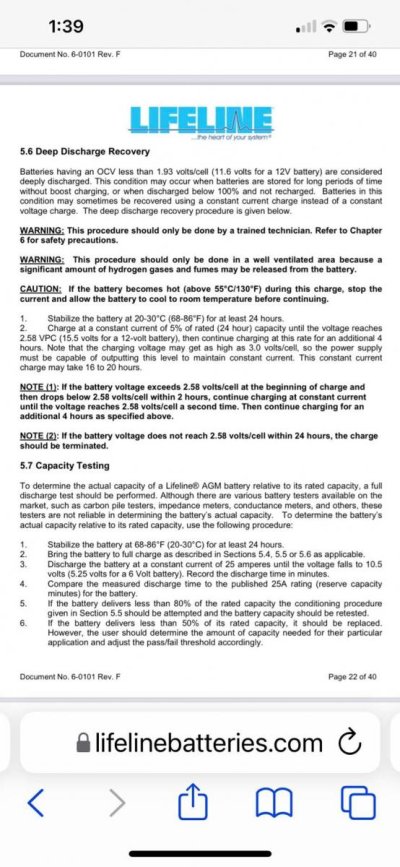cardude01
Guru
- Joined
- Nov 26, 2012
- Messages
- 5,290
- Location
- USA
- Vessel Name
- Bijou
- Vessel Make
- 2008 Island Packet PY/SP
I recently replaced my 4 Lifeline 125ah AGM batteries in the house bank with new ones. They were 7 years old and had been pretty severely discharged when my boat got caught in Dorian in the Bahamas 2.5 years ago. My 12v bow thruster is hooked up to this house bank and on our last trip the thruster would barely work.
Got the new batteries in and everything working well now.
I brought the old batteries back home thinking maybe I could use them for something, like on my electric boat for lights or maybe for a house bank for a solar project or something. When I tested them three of them were at 12.9 volts (after sitting uncharged for two weeks) and one was at 11.7 volts. I’m attempting to charge that discharged battery to see if will hold a charge, but I suspect it has a problem.
Lifeline has a method to bring back a sulfated battery, and I was wondering if anyone had tried that before with any success. Or should I try something else? I’m currently charging that discharged battery at 10 amps for 7 hours as recommended by Lifeline to see what happens. Maybe it will hold a charge?

Got the new batteries in and everything working well now.
I brought the old batteries back home thinking maybe I could use them for something, like on my electric boat for lights or maybe for a house bank for a solar project or something. When I tested them three of them were at 12.9 volts (after sitting uncharged for two weeks) and one was at 11.7 volts. I’m attempting to charge that discharged battery to see if will hold a charge, but I suspect it has a problem.
Lifeline has a method to bring back a sulfated battery, and I was wondering if anyone had tried that before with any success. Or should I try something else? I’m currently charging that discharged battery at 10 amps for 7 hours as recommended by Lifeline to see what happens. Maybe it will hold a charge?

Last edited:
